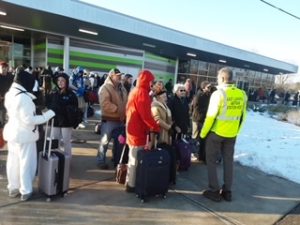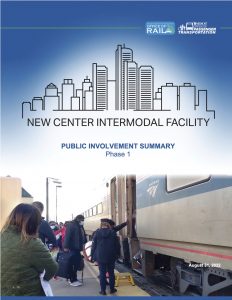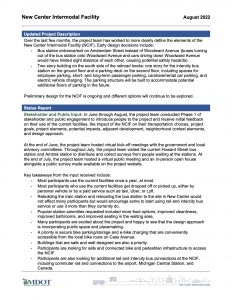Next Year’s Northern Michigan Rail Study Will Welcome Critics, Concerns
By James Bruckbauer
Transportation & Community Design Program Director
Groundwork Center for Resilient Communities
The idea of creating a passenger rail connection to northern Lower Michigan reached an exciting milestone this year when state and federal lawmakers announced funding support for the next phase of planning. But even though many people think the news is a win for Michigan cities, the idea has its share of critics.
The good news is this: The planning team wants to hear your feedback and opinions on the idea, even if you oppose the idea. In 2023 the study team will seek feedback from people all over Michigan so residents themselves can shape the potential service.
The idea itself came from the public speaking up. A little over a decade ago, during an extensive and extremely well-attended regional transportation land use visioning process, many Grand Traverse region residents enthusiastically said they wanted to see passenger train service restored to Traverse City. They saw the potential of fewer cars on the roads, less freeway congestion, more and safer travel options and rail’s economic boost to downtowns. The idea grew out of public interest and people speaking up, not top-down planning.
Big infrastructure projects impact many people, and passenger rail service to northern Michigan could have a huge impact on travelers, neighborhoods, cities, and taxpayers. When the news broke of federal and state funds approved to support the next phase of planning work—a study that will identify necessary equipment and capital upgrades and also outline a potential business plan for passenger service—many around the state celebrated the key milestone. Others, however, raised their concerns about potential costs, neighborhood impacts, the quality of previous study info, needs, and focus on tourism.
A recent letter to the Traverse City Record-Eagle claimed that the train line will cost a billion dollars and carry 1,500,000 wealthy visitors a year to Traverse City. Others have expressed a deep fear that the line will be focused on bringing too many more visitors to an already tourist-heavy Traverse City. The nonprofit Michigan Capital Confidential questioned the ridership projections in an earlier study and falsely claimed that the same ridership numbers will be used in the Phase II plan.
While I can’t control what people say or write about the idea in the public realm, I will always respond to specific questions about the project, and the 2023 study will be done in a way that recognizes and addresses your concerns.
In the meantime, here are few things key things to remember over the holidays as Groundwork works with many partners to launch the study early next year:
- The study is focused on a set of tracks that are already owned by the state of Michigan. Rail experts will explore how the state can maximize its own existing and active rail line that runs between southeast Michigan and the Traverse City and Petoskey areas, and runs through cities like Owosso, Mt. Pleasant, and Cadillac.
- The tracks are being used right now to carry freight products, and the study will look at how passenger and freight can coexist on the tracks.
- The initial 2018 study looked at many different scenarios, from 25 m.p.h. excursion trains to trains with speeds of up to 110 m.p.h. on some sections. The more realistic options, like 60–80 m.p.h. trains, were expected to cost a fraction of the high-priced 110 m.p.h. option. The next step is to boil those different ideas down to a real plan with updated cost estimates.
- The line also connects to Michigan’s important east/west passenger rail lines, and we feel it’s essential to connect people to the Detroit to Chicago Amtrak service, which is a rail line that has seen hundreds of millions of dollars of investment to make faster, more reliable train service.
- The team that worked on the 2018 study used a detailed method of estimating ridership, aggregating three main sources: 1) existing travel demand models from local transportation planning agencies throughout Michigan, which shows where vehicle trips start and end in Michigan, and including mode and purpose; 2) the socioeconomic growth projections for the areas along the lines; 3) and a “travel desirability analysis” that looks at people’s likelihood of driving vs. taking a plane or train, based on cost and travel time.
- Sure, visitors make up many mid- and northern Michigan trips. However, the focus for the next study will be on business, university, medical, and everyday travel in the state.
- The capital costs, operating costs, safety upgrades, and ridership forecasts will all be updated, but another piece that will be important to determine is the operating and management structure that should be created.
- I would like this next phase help us understand if there’s a viable service here that does not have to depend on public financial support. We believe there’s an opportunity to get creative with different revenue and private funding structures and create an innovative new model for train service.
- The Northern Michigan passenger rail line is included in the Michigan Department of Transportation’s State Rail Plan and long-range Mobility 2045 plan.
As we close out the year, we’re excited about this project. Unlike most major transportation projects, residents and travelers will get a say and have a voice in shaping this vision for potential future passenger train service that they want in their communities—which is especially fitting for a project that was first proposed in public visioning sessions.





